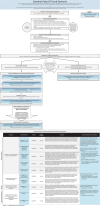Pharmacological and neurosurgical management of cerebral palsy and dystonia: Clinical practice guideline update
- PMID: 38640091
- PMCID: PMC11579811
- DOI: 10.1111/dmcn.15921
Pharmacological and neurosurgical management of cerebral palsy and dystonia: Clinical practice guideline update
Abstract
Dystonia, typically characterized by slow repetitive involuntary movements, stiff abnormal postures, and hypertonia, is common among individuals with cerebral palsy (CP). Dystonia can interfere with activities and have considerable impact on motor function, pain/comfort, and ease of caregiving. Although pharmacological and neurosurgical approaches are used clinically in individuals with CP and dystonia that is causing interference, evidence to support these options is limited. This clinical practice guideline update comprises 10 evidence-based recommendations on the use of pharmacological and neurosurgical interventions for individuals with CP and dystonia causing interference, developed by an international expert panel following the Grading of Recommendations, Assessment, Development and Evaluations (GRADE) approach. The recommendations are intended to help inform clinicians in their use of these management options for individuals with CP and dystonia, and to guide a shared decision-making process in selecting a management approach that is aligned with the individual's and the family's values and preferences.
© 2024 The Authors. Developmental Medicine & Child Neurology published by John Wiley & Sons Ltd on behalf of Mac Keith Press.
Figures
References
-
- Sanger TD, Delgado MR, Gaebler‐Spira D, Hallett M, Mink JW, Disorders TFoCM . Classification and definition of disorders causing hypertonia in childhood. Pediatrics. 2003;111(1):e89‐e97. - PubMed
-
- Jethwa A, Mink J, Macarthur C, Knights S, Fehlings T, Fehlings D. Development of the Hypertonia Assessment Tool (HAT): a discriminative tool for hypertonia in children. Developmental Medicine & Child Neurology. 2010;52(5):e83‐e7. - PubMed
-
- National Institute of Neurological Disorders and Stroke . Dystonia Bethesda, MD: National Institute of Neurological Disorders and Stroke; [updated 2023 Jan 20; cited 2023 Feb 1]. Available from: https://www.ninds.nih.gov/health‐information/disorders/dystonia.
-
- Rosenbaum P, Paneth N, Leviton A, Goldstein M, Bax M, Damiano D, et al. A report: the definition and classification of cerebral palsy April 2006. Dev Med Child Neurol Suppl. 2007;109(suppl 109):8–14. - PubMed
Publication types
MeSH terms
Grants and funding
LinkOut - more resources
Full Text Sources
Medical
Miscellaneous


